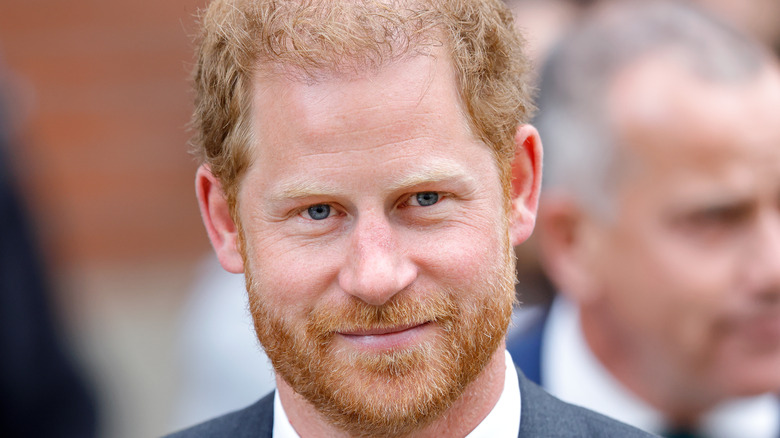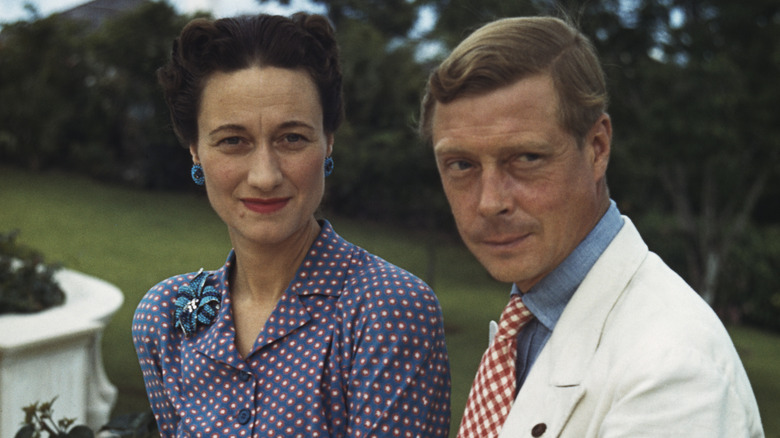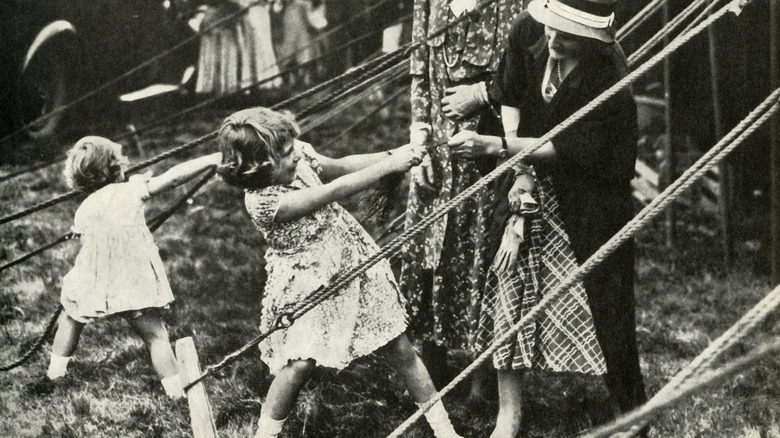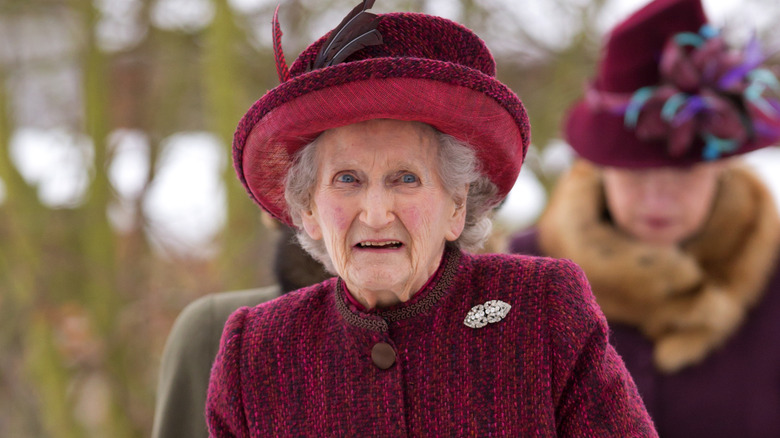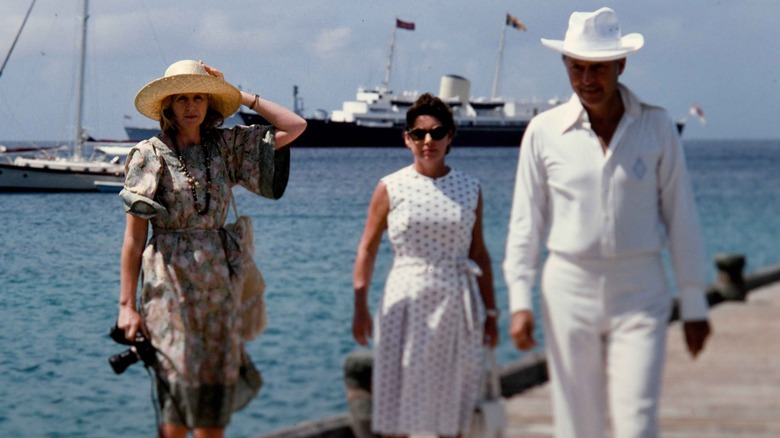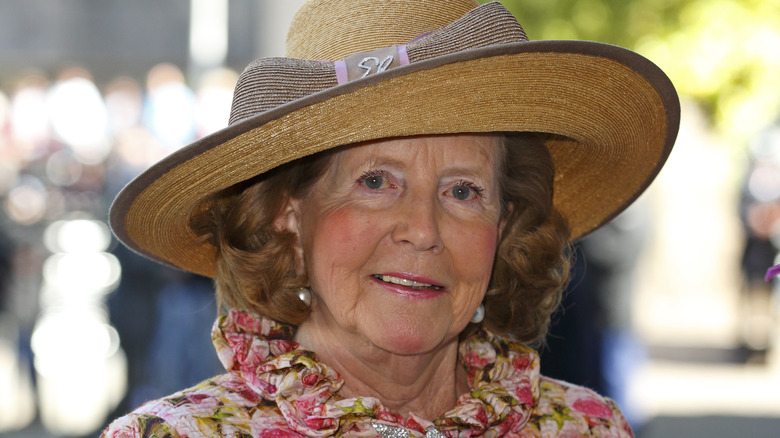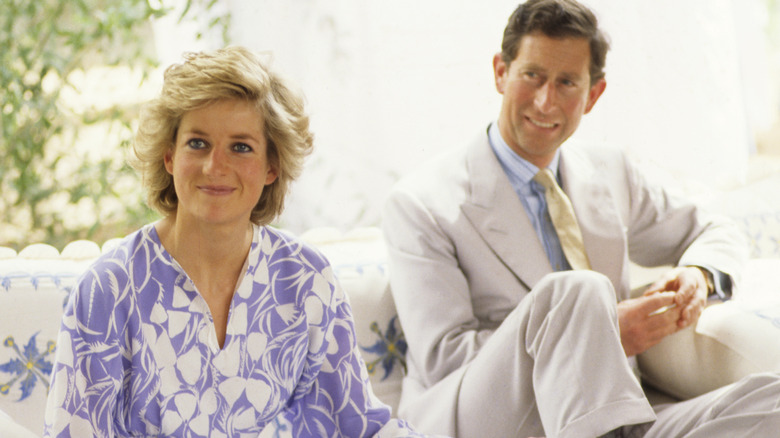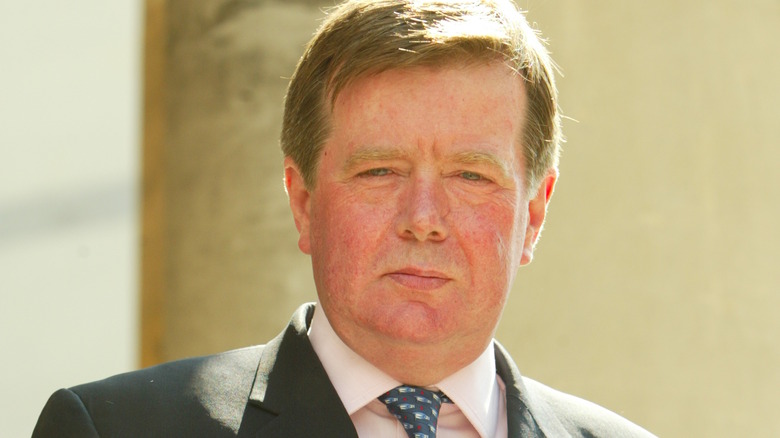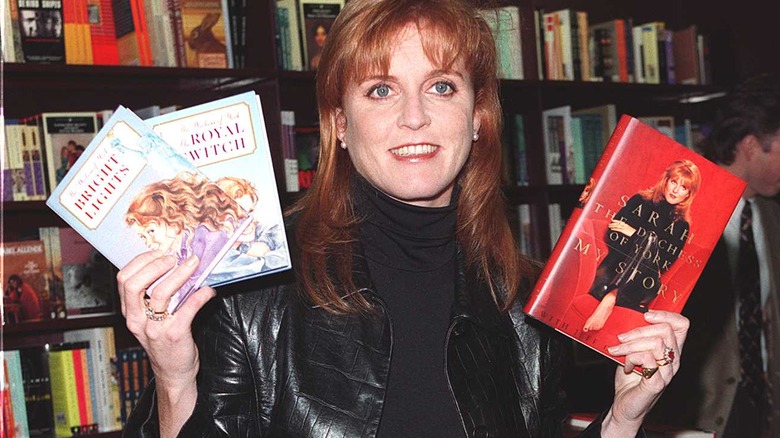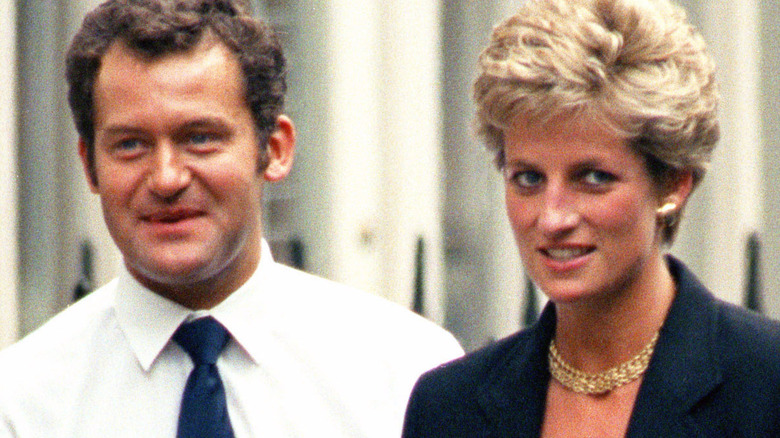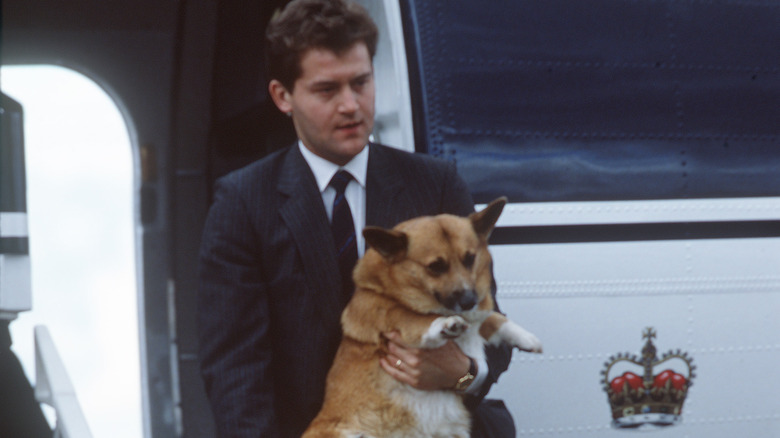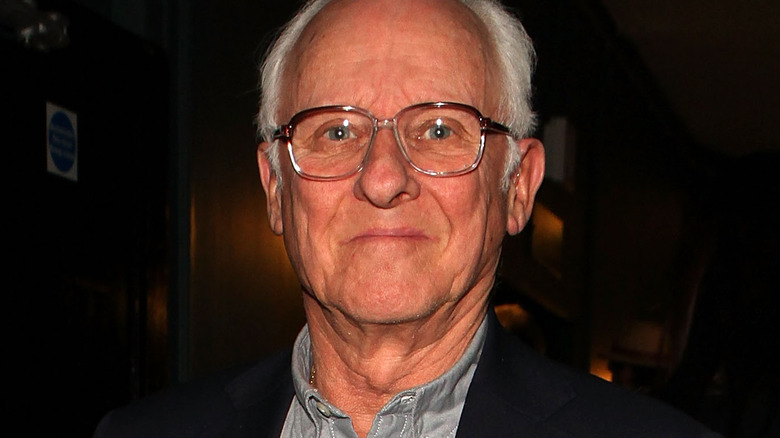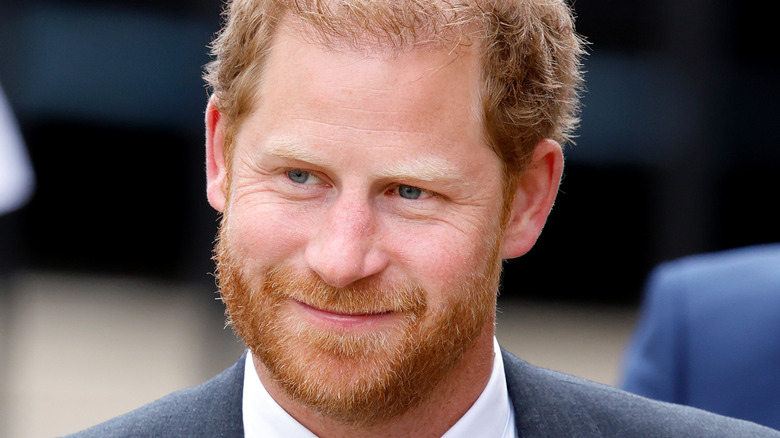12 Memoirs That Spilled The Royals' Juiciest Secrets
On January 10, 2023, Prince Harry stunned the world with the publication of his memoir, "Spare." The book's release captivated the attention of fans across the globe, selling a record-breaking 1.43 million copies, according to The New York Times. Part of the memoir's appeal, of course, was Harry's firsthand insight into the inner life of the British royal family. Far from the serious — and rather severe — image that most royals have traditionally shown to the public, Harry's portrayal of his own family is highly personal and often negative.
Indeed, the prince famously used "Spare" to allege that his older brother, William, once physically assaulted him. He also claimed that his father, King Charles III, didn't even hug him upon discovering that Princess Diana died. All in all, these allegations proved extremely controversial. While Harry and Meghan Markle have been supported by important figures, like Oprah Winfrey, they have also faced a great deal of backlash. As royal expert, Richard Fitzwilliams, told US Weekly when asked if Harry and Meghan will get an apology from the royal family, "I think it's absolutely clear that that is not an option" (via YouTube).
Interestingly, however, "Spare" is far from being the only royal memoir to ever shake the institution. From King Edward VIII's earth-shattering confessions about his pursuit of Wallis Simpson to a palace press secretary's account of Diana and Charles' divorce, more than one royal memoir has laid out the royal family's deepest secrets to the public.
1. A King's Story
Long before Prince Harry's "Spare" revelations rocked the royal family, a former king of England bared his love story to the world. In 1951, King Edward VIII published "A King's Story," a memoir in which he recounted the intimate details of his romance with an American divorcée named Wallis Simpson. To this day, Edward is perhaps best known for this relationship, which was, in the 1930s, considered inappropriate for a British king. Ultimately, Edward chose love over duty and abdicated the throne to marry Wallis.
In chapter 14 of his memoir, Edward recalled the first time he ever came across Wallis. "It was during the winter after my return from South America in 1931. I had gone to Melton Mowbray with my brother George for a weekend's hunting. Mr. and Mrs. Simpson were guests in the same house." In an attempt to make conversation with Wallis, Edward wrote that he asked her how she was faring without the American comfort of central heating. To this, Wallis responded, "I am sorry, sir, but you have disappointed me. ... Every American woman who comes to your country is always asked that same question. I had hoped for something more original from the Prince of Wales."
Not long after that interaction, Edward was hooked. In his autobiography, he revealed that Wallis' intelligence drew him in: "She was extraordinarily well-informed about politics and current affairs. ... Her conversation was deft and amusing."
2. The Little Princesses
Although King Edward VIII's autobiography was revealing, there was another royal memoir that was arguably much more controversial. Written by royal nanny Marion Crawford, "The Little Princesses" is a tell-all recounting Crawford's experience raising the young princesses, Elizabeth and Margaret. Although highly autobiographical, Crawford's book also offers an intimate glance into the marriage of King George VI and his wife, Queen Elizabeth, the queen mother.
Hired in 1931, while George and the elder Elizabeth were still the Duke and Duchess of York, Crawford was quick to note the loving relationship between her bosses. She wrote that the pair "were devoted to each other and very much in love, and I remember thinking they looked just as a duke and duchess ought to look, but often don't" (via London Review of Books). Crawford also described the couple's evening rituals, sitting by the fireplace, while George did some relaxing needlework.
As for the little princesses, Crawford described a straight-laced future Queen Elizabeth and a more theatrical Princess Margaret. Apparently, Elizabeth even used to try to correct her younger sister's behavior. The nanny mused, "How often ... have I heard [Elizabeth] cry in real anguish, 'Stop her, Mummie. Oh, please stop her,' when Margaret was being more than usually preposterous, and amusing, and outrageous." Unfortunately, however, the revelations from this memoir were just too personal for the royal family to bear. Shortly after its publication, Crawford was expelled from royal grounds. She was never spoken to by the royal family again.
3. The Final Curtsey
While some royal memoirs are deeply controversial, some are published with the British royal family's blessing. In 2012, Queen Elizabeth's cousin, Margaret Rhodes, published "The Final Curtsey" — but not before getting the queen's stamp of approval. The book sheds light on the intimate details of life from within the confines of Buckingham Palace, including the death of Queen Elizabeth, the queen mother.
Describing the moment she lost the queen mother forever, Rhodes wrote, "The dresser asked me if I would like to see my aunt. She looked lovely and almost younger, death having wiped the lines away" (via Royal Central). Never turning her back on royal protocol, Rhodes recalled showing the deceased queen one last sign of respect: "I knelt by her bed and said a prayer for her. Then I stood up and gave her my final curtsy."
It then apparently fell to Rhodes, as a Woman of the Bedchamber chosen by the late queen mother, to report her aunt's passing to the Windsor Registrar's office. There, Rhodes wrote that the public servant on duty asked her: "Right, what was the husband's occupation?" (via NZ Herald). In what to most would likely seem a surreal moment, Rhodes says she replied: "King." Recalling the interaction in her memoir, she joked, "I think [she] might have found that almost amusing."
4. Lady in Waiting
Princess Margaret may have been famous for her party girl behavior, but Anne Tennant, Baroness Glenconner, had a different perspective on the rebellious royal. As one of the princess' ladies-in-waiting, Tennant developed a deep friendship with Margaret — and she recounted the tale of their friendship in her 2019 memoir, "Lady in Waiting." According to Tennant's account, when she and her husband, Colin Tennant, purchased the island of Mustique in 1958, Margaret was one of the first "brave" souls to venture out to the private destination. With no electricity or running water available on the island, Tennant was initially concerned about the princess' ability to enjoy the experience. However, it seems, Margaret surpassed her host's expectations.
Of their time together on Mustique, Tennant wrote, "[Margaret] arrived with no fuss a few months later, happily using the bucket of water in the trees to shower, just like we did. The food, too, was basic: although we had fresh fish, everything else was tinned. She didn't seem to mind" (via The Daily Mail). In addition to this astonishing insight into Margaret's character, Tennant discussed some of the deeper, personal issues that the princess faced in her marriage to Lord Snowdon. Describing the home that Margaret eventually built on Mustique, Tennant shared, "It was the only house she ever owned and it made her very happy because apart from being beautiful it provided her with an independent base from her husband."
5. Whatever Next?
In her first royal memoir, Anne Tennant may have provided some fascinating information about Princess Margaret's private life. However, in the 2023 follow-up, "Whatever Next?" Tennant discussed the pain that she and Margaret shared, thanks to their similarly failed marriages. Speaking to Fox about some of the revelations made in this second autobiography, Tennant revealed that Margaret "knew Colin [Tennant] had a terrible temper. He used to lose his temper in front of her. So she knew it."
Interestingly, the topic of unhappy marriages was one that drew the two women to each other. In her interview with Fox, Tennant remembered the way that their friendship provided support and companionship when their husbands couldn't be there for them. She explained, "And [Margaret] was in a very difficult marriage herself ... For one wonderful year, I lived with her ... We would just talk and talk." Apparently, the living arrangement ended on a high note. As Tennant said, "And in the end, when I left, [Margaret] said, 'I really enjoyed having you, Anne. We got on so well. So much better than our awful husbands.' We just had to laugh. You have to laugh. Otherwise, life is impossible."
In addition to her friendship with Margaret, however, Tennant's memoir makes serious allegations of domestic violence against her husband. The lady-in-waiting wrote that her husband threw objects at her and even used a stick to beat her. Therefore, this book deserves a trigger warning.
6. The Housekeeper's Diary
Members of the British royal family tend to love their privacy, but that doesn't mean that they are ever absolutely alone. Thanks to the presence of butlers, maids, and other staffers, royals can't always keep their intimate secrets under wraps. That was certainly the case for King Charles III and Princess Diana, whose housekeeper, Wendy Berry, witnessed the disintegration of their marriage. Following her time as a housekeeper at Kensington Palace and Highgrove House, Berry proceeded to write a royal memoir, "The Housekeeper's Diary." The result was so controversial that it was banned in Great Britain.
In the book, Berry claimed that Charles and Diana went to great lengths to make it seem like their marriage was still functional. In one anecdote, Berry wrote that Diana used to plant her earplugs between Charles' sheets in the morning to make it seem that she had slept with him (per Five Books).
Although these kinds of bombshell accusations are the ones that landed the book on the "banned" list, much of Berry's account reveals what it's actually like to work for the Windsors. For example, the housekeeper described Charles' hard-boiled egg preferences: "I knew that Charles wanted his eggs cooked for three minutes exactly, and that Mervyn [the chef] usually had several lots on the go to ensure that at least one batch was perfect. The others were simply thrown away" (via The Daily Mail). Berry marveled at the number of eggs that were tossed out at Charles' request, writing, "Now that's royal service for you."
7. Diana: Closely Guarded Secret
Princess Diana is famous in the popular imagination for being a figure that's nearly impossible to understand. Thanks to the media's outrageous — and at times contradictory — stories about the princess, not many individuals could say that they knew her. Diana's bodyguard, Ken Wharfe, however, was one of those few people who claimed to understand her. In his memoir, "Diana: Closely Guarded Secret," Wharfe opened up about his time working for one of the most iconic women in the world. His book makes several allegations about the princess' love life, including claims about her relationship with the cavalry officer, James Hewitt.
In the book, Wharfe dedicated particular detail to the disintegration of Diana's romance with Hewitt. Per the bodyguard's recollections, Hewitt was offered a new military posting as a part of a promotion. In turn, Diana "tried everything in her power to prevent Hewitt from accepting the posting. She even suggested that she would raise the issue with his commanding officer" (via ABC News).
Ultimately, Wharfe wrote, Hewitt took the job — prompting Diana to end their romance. Even so, the bodyguard claimed that Diana felt Hewitt's loss deeply: "She was often moody, sometimes tearful, and occasionally furious." These descriptions provide an interesting new perspective into Diana's psyche and how she perceived some of her most famous relationships.
8. My Story
On July 23, 1986, Sarah Ferguson married Prince Andrew and became the Duchess of York. Shortly following the magic of the royal wedding, however, Sarah suffered greatly at the hands of the press. Labeled "the Duchess of Pork" by cruel and inappropriate media outlets, Sarah developed an eating disorder. A few years later, Sarah separated from Andrew and exited the inner fold. In the royal memoir, "My Story," Sarah opened up about her motivations for dipping out of royal life.
According to her account, 1992 was a huge year for Britain's most famous family. Sarah recalled, "The queen would later call it her annus horribilis, the year of torn mornings and shattered peace" (via Express). Indeed, it was in this year that Sarah and Andrew parted ways, at least informally — the two would officially divorce in 1996. Even so, it was in '92 that "Andrew and I had been discussing a separation."
Per the duchess, the reason had little to do with her love for Andrew and everything to do with her hatred for royal life. She wrote, "I had reached the end of my royal rope. For six years I had shouldered the demands of palace life. I'd endured the constant scrutiny of the British press and the barely veiled hostility of the royal household ... They were killing me by inches." Thus, her memoir echoes the stories of royal women, like Princess Diana and Meghan Markle.
9. A Royal Duty
When Princess Diana and King Charles were divorced in 1996, Di let go of almost all of her staff. Paul Burrell, her butler, was one of the few she kept on — and he was said to be Diana's friend and confidant as much as he was her employee. Because of this, Burrell's 2003 book, "A Royal Duty," reveals a totally different side to Diana.
This royal memoir specifically recalls the princess' state following her divorce from Charles, and, per Burrell's account, she was largely feeling hopeful. At one point, Burell related how excited Diana was about regaining control over her decisions: "There was one more thing. Something she had always talked about. The one thing she had always wanted at Kensington Palace but felt was not possible. 'And we can get a dog,' she said" (via ABC News).
More than adopting a puppy, however, Diana quite possibly dreamed of moving to the United States. Burrell wrote that the princess fantasized about her new life abroad: "We sat there imagining the American lifestyle: The jogs along the beach, the constant sunshine, the sense of freedom." He said that she dreamed of using her platform to help people from around the world. Apparently, Diana even told him, "We can travel the world, Paul, and seek out all those people who need help." In that sense, Burrell's book paints a portrait of who Diana could have become had she lived past that fateful day in 1997.
10. The Way We Were
Princess Diana's former butler, Paul Burrell, published not one, but two, books about what it was like to work for the ill-fated People's Princess. Published in 2006, the second royal memoir, "The Way We Were," focused on Burrell's friendship with Diana. Recalling the time when Diana was finalizing her divorce from King Charles III, Burrell wrote how the princess took out her revenge on her ex's wallet.
When it came time to renovate Diana's Kensington Palace apartments, the princess apparently told her butler, "Make a list of everything we need and let's spend a bit more of his money while we can!" (via ABC News). In what Burrell described as some lighthearted mischievousness, "We bought new towels, sheets, duvet covers, pillowcases, china, crockery, silver, and kitchenware."
Despite the tone of this story, many of Burrell's anecdotes are wholesome, even providing insight into what she was like as a mom. The butler remembered, "My sons, Alexander and Nick, were often invited up to the palace to play with William and Harry." He went on to describe how informal Diana could be when playing with her boys: "Sometimes the princess joined the boys in that [sitting] room for burgers and fries, fish fingers, or spaghetti Bolognese, served on trays or foldaway tables."
11. On Duty with the Queen
It's no secret that managing the British royal family has a complicated relationship with the media, but perhaps no one understands this as clearly as Dickie Arbiter. Arbiter, who worked as the media manager for King Charles III and Princess Diana, witnessed quite a bit of chaos during his time with the royals. In his 2014 book, "On Duty with the Queen," the press officer related many of the challenges he faced while managing the ill-fated couple's public image.
In one particularly engaging anecdote, Arbiter discussed the episode when Diana dodged Charles' kiss at the end of a polo match in India. This moment was famously a public relations disaster for the royal family, as it bared their marital dissatisfaction for the world to see. Fascinatingly, Arbiter's royal memoir claimed that Diana orchestrated the moment herself, writing, "Incensed, the princess swiveled her head so that the kiss landed near her ear. The crowd, as well as those of us accompanying the royal couple, could only cringe. The prince had clearly been intentionally humiliated, and we knew he'd be furious" (via The Mirror).
12. Spare
Prince Harry's memoir, "Spare," is most famous for the bombshell accusations that it makes against certain members of the royal family. However, the book also reveals a softer side of Harry, even detailing the way he reacted to Princess Diana's death. At one point, the prince admitted to believing that Diana had orchestrated the whole accident in order to fake her death. Harry wrote, "Suspicion took hold, which then became a firm belief ... Her life's been miserable, she's been hounded, harassed, lied about, lied to. So she's staged an accident as a diversion and run away" (via The Independent).
The prince also discussed why he believed that the press was, ultimately, responsible for his mother's death. He explained, "Even if the [driver] had been drinking, even if he had been drunk, he wouldn't have had any problem driving through such a short tunnel. Unless paparazzi were following him and dazzled him" (via Yahoo).
